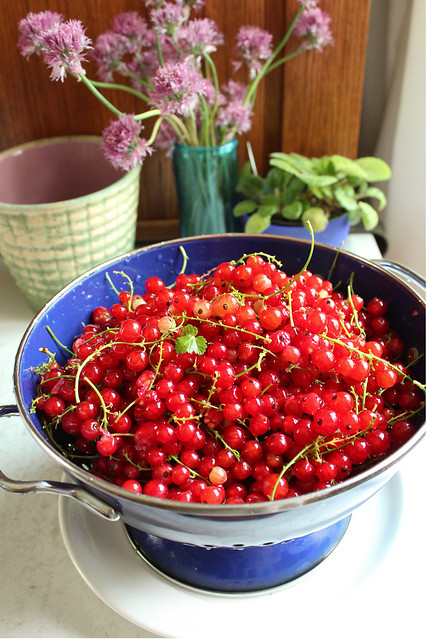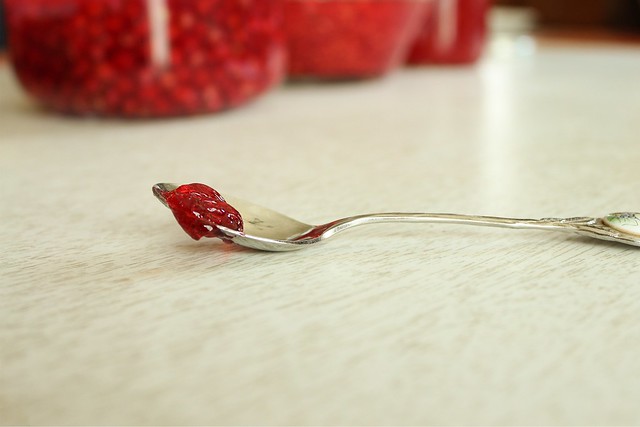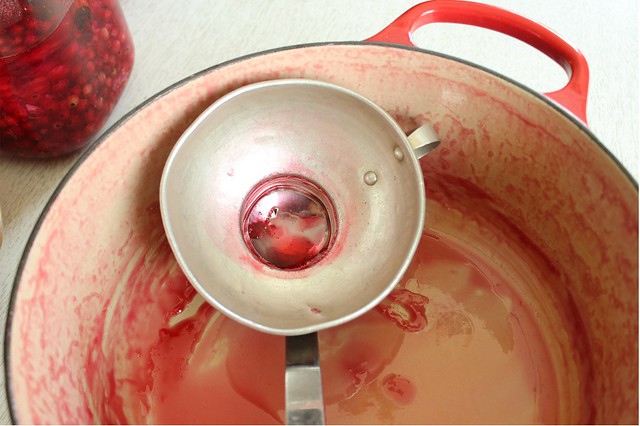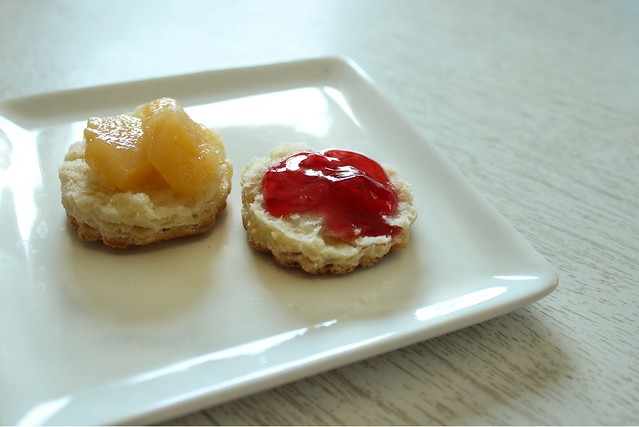Well, yesterday's doctor visit confirmed that baby number 2 will likely be late, like baby number 1 was. Am I such a good hostess that my children just don't want to enter the world? As I look past my tomorrow due date, I try to remember to be patient and also try to remember that there will still be a good amount of summer left after I get back to feeling normal.
Part of my impatience has to do with the normalcy that I crave. Ordinarily, as soon as the weather warms I find myself interested in searching out new and different things to preserve and then beyond excited to take their pictures and write about them. My new normalcy is the feeling that I can't really plan anything, go anywhere too far away, and certainly not to wait around on ripening produce. It's frustrating for me because I'm not a good idler, I prefer my old spirit of juggernauting forward, that always propelling forward motion that feels so good, especially in the summertime.
When I woke up early on July 4th (every day, I wake up at exactly 5:22, don't ask me why...), I found a message from a localish orchard; the currants I'd been looking forward to experimenting with for the past 2 years were finally ready, and the farmers had two ice cream pails already picked and waiting for me if I was still interested, and hadn't had my baby yet. For a brief moment, I felt my old self return. I hopped out of bed and immediately searched my sources to see about how many currants I'd need to do the few things I had in mind.
I'm not used to depending on others to do what I'd like, especially when it comes to climbing behind the wheel of the car and taking off on a whim. In our family, I'm the usually always the driver, in part because I just love the road (and in part because I'm a terrible passenger). But this close to a delivery date, I'm not driving much - and not very far. I was actually surprised that my Husband offered to drive us down to the little farm where the currants were, even more surprised that he tried different varieties of currants and gooseberries, and was interested in the workings and stories that the husband and wife team running Klee's Out on a Limb Acres had to offer. It was a perfect afternoon, and even though the journey wasn't actually so far away, it was was just rural enough to satisfy the summertime longings for the country that always plague me - and it was even better that my boys were both appearing to be enjoying every minute as much as I was.
I have had currants on the brain for two years. It's been more than that long since I first had a tipple made by friends Paul and Lori of the Burp! blog, and I was really smitten. Their liqueur had been aged for quite some time by the time I tried it, and it was earthy, complex, and just plain lovely. As I'd never even seen currants growing, and never picked or tasted one, I longed to find a source so that I could anticipate tiny cupfuls of that delicious liqueur of my own making - and experiment with other things as I usually do when I get too excited over a new best friend and overbuy considerably.
Part of my impatience has to do with the normalcy that I crave. Ordinarily, as soon as the weather warms I find myself interested in searching out new and different things to preserve and then beyond excited to take their pictures and write about them. My new normalcy is the feeling that I can't really plan anything, go anywhere too far away, and certainly not to wait around on ripening produce. It's frustrating for me because I'm not a good idler, I prefer my old spirit of juggernauting forward, that always propelling forward motion that feels so good, especially in the summertime.
When I woke up early on July 4th (every day, I wake up at exactly 5:22, don't ask me why...), I found a message from a localish orchard; the currants I'd been looking forward to experimenting with for the past 2 years were finally ready, and the farmers had two ice cream pails already picked and waiting for me if I was still interested, and hadn't had my baby yet. For a brief moment, I felt my old self return. I hopped out of bed and immediately searched my sources to see about how many currants I'd need to do the few things I had in mind.
I'm not used to depending on others to do what I'd like, especially when it comes to climbing behind the wheel of the car and taking off on a whim. In our family, I'm the usually always the driver, in part because I just love the road (and in part because I'm a terrible passenger). But this close to a delivery date, I'm not driving much - and not very far. I was actually surprised that my Husband offered to drive us down to the little farm where the currants were, even more surprised that he tried different varieties of currants and gooseberries, and was interested in the workings and stories that the husband and wife team running Klee's Out on a Limb Acres had to offer. It was a perfect afternoon, and even though the journey wasn't actually so far away, it was was just rural enough to satisfy the summertime longings for the country that always plague me - and it was even better that my boys were both appearing to be enjoying every minute as much as I was.
Last year, our whole state was devastated by a strange and early spring promptly followed by a killing frost. Sadly it left us without many cherries, apples, and other orchard fruits, and when you could find them, they were almost prohibitively expensive. The entire season was decimated for small timers like Klee's - they had no crops for sale last year at all - and that was the year that I read about them and found that they grew old-timey things I was looking for like gooseberry, quince, and currants.
I have had currants on the brain for two years. It's been more than that long since I first had a tipple made by friends Paul and Lori of the Burp! blog, and I was really smitten. Their liqueur had been aged for quite some time by the time I tried it, and it was earthy, complex, and just plain lovely. As I'd never even seen currants growing, and never picked or tasted one, I longed to find a source so that I could anticipate tiny cupfuls of that delicious liqueur of my own making - and experiment with other things as I usually do when I get too excited over a new best friend and overbuy considerably.
I double checked with Lori to be sure the drink I had tasted so long ago was made with red currants and vodka, because as I recall it was dark in color and so deep and raisiny tasting I couldn't imagine the jewel red berries resting out so much. I made the recipe exactly as they suggest, not adding or subtracting a single thing... and I plan to age it until at least Christmas before trying it.
I had just enough Mount Gay rum left in the bottle (given to me so I could make flourless chocolate rum cakes for a friend's birthday in January) to do a batch of Pam Corbin's Currant Shrub. I was under the impression that shrubs were usually non-alcoholic, sweetened vinegar bases that were mixed with seltzer. But, in her book The River Cottage Preserves Handbook, she details this one made with red currant juice and rum (or brandy). Also taking several months to mature, I figured another thing to try around Christmastime would be welcome.
I had just enough Mount Gay rum left in the bottle (given to me so I could make flourless chocolate rum cakes for a friend's birthday in January) to do a batch of Pam Corbin's Currant Shrub. I was under the impression that shrubs were usually non-alcoholic, sweetened vinegar bases that were mixed with seltzer. But, in her book The River Cottage Preserves Handbook, she details this one made with red currant juice and rum (or brandy). Also taking several months to mature, I figured another thing to try around Christmastime would be welcome.
Pam's shrub is so easy to make. I knew I was already doing a batch of currant jelly and simply steamed enough extra currants to allow for the 1 1/4 cups for this recipe. Given my state of pregnancy, I steamed the berries on July 4th, and made the jelly and liqueurs the next day. For every pound of currants, I used Linda Ziedrich's advice and added 1/2 cup of water. (I did 4 1/2 lbs of currants and 2 1/4 cups water, and had more than enough juice for this recipe and a batch of jelly.)
Pam Corbin's Currant Shrub
- 1 1/4 c. red currant juice
- 2 1/2 c. rum (or brandy)
- finely grated zest of one orange
- 1 t. freshly grated nutmeg
- 1 1/2 c. granulated sugar
Mix the currant juice with rum (or brandy), orange zest, and nutmeg. (Currants are naturally high in pectin, and adding the juice to alcohol may cause it to form a gel, as it did for me. Corbin says it will turn back to a more liquid state after the sugar is added.) Let this mixture stand for 7-10 days well sealed and in a dark place.
Transfer the mixture to a pan, add sugar and heat gently just to dissolve sugar, about 140 degrees. Strain the mixture through muslin or cheesecloth, decant into a sterilized jar (I saved the rum bottle), seal tightly, and let age for several months (again, in a cool, dark place) before enjoying. Drink within 2 years.
The way the currant juice gelled with the alcohol and suspended the orange zest within the jar was absolutely mesmerizing. As was the intoxicating (literally) scent of warm orange, nutmeg, rum, and currant. It was hard to stash this one away in a dark place, I can tell you that.
After I had my liqueurs underway and tucked away, I tackled the jelly - which is so simple. Both Linda Ziedrich and Pam Corbin had methods that used equal measures juice and sugar - so I used 4 cups juice and 4 cups raw sugar. I thought maybe I'd like to add something "unique" to the jelly, but once the sugar dissolved and I tasted it, I couldn't bear to mar the clean flavor. It is simple and delicious, and though I've pledged not to overmake in the preserves department this year, the 5 half pints of jelly are very welcome on my shelf!
Sugar preserved quince, and fresh currant jelly.
I couldn't be happier with this 4th of July, and even though my spirits were dampened a bit with the thoughts of an overdue baby, I have to say the currants broke me free of feeling a bit sorry for myself. If you are local and looking for a nice little farm to pick your own currants, gooseberries, quince, elderberries and other old-fashioned orchard fruits, check out Klee's! They have a webpage, and update a Facebook page (and are quick to return questions if you give them a call. Give them a "like" to stay updated, and take a little drive. Candy shared with me a little jar of quince, which was also a first taste for me. If I'm feeling up to it, I plan to get some to play around with... just as soon as it ripens, and this baby comes!


































